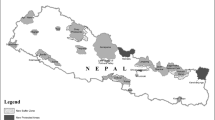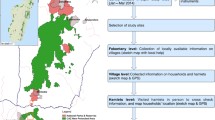Abstract
A large number of economically disadvantaged people live around protected areas. Conservation efforts that focus on poverty alleviation, work on the premise that an increase in household wealth decreases use of forest resources. We surveyed 1222 households across four tiger reserves to test the paradigm that an increase in assets leads to reduced forest use and we also assess the effects of other socio-economic factors. We find that increase in assets may reduce Non-timber Forest Product (NTFP) collection, but may not necessarily reduce livestock numbers or use of wood as a cooking fuel. Households that faced more economic setbacks were more likely to state that they wanted more livestock in the future. Education is positively associated with choosing Liquefied Petroleum Gas as a cooking fuel in the future. We find site and resource-specific variation. Fifty percent of all households (range across sites: 6–98) want to collect NTFP while 91% (range: 87–96) want to retain or own more livestock over the next 5–10 years. Understanding current and future resource use will help plan context-specific conservation efforts that are better aligned with reducing specific pressures around protected areas.





Similar content being viewed by others
References
Agarwala, M., R.S. DeFries, Q. Qureshi, and Y.V. Jhala. 2016. Changes in the dry tropical forests in Central India with human use. Regional Environmental Change 16: 5–15.
Anderson, I., B. Robson, M. Connolly, F. Al-Yaman, E. Bjertness, A. King, M. Tynan, R. Madden, et al. 2016. Indigenous and tribal peoples’ health (The Lancet–Lowitja Institute Global Collaboration): A population study. The Lancet 388: 131–157.
Angelsen, A., P. Jagger, R. Babigumira, B. Belcher, N.J. Hogarth, S. Bauch, J.B.C. Smith-Hall, and S. Wunder. 2014. Environmental income and rural livelihoods: A global-comparative analysis. World Development 64: 12–28.
Barrett, C.B., T. Reardon, and P. Webb. 2001. Nonfarm income diversification and household livelihood strategies in rural Africa: Concepts, dynamics, and policy implications. Food Policy 26: 315–331.
Belcher, B., R. Achdiawan, and S. Dewi. 2015. Forest-based livelihoods strategies conditioned by market remoteness and forest proximity in Jharkhand, India. World Development 66: 269–279.
Bennett, N.J., 2016. Using perceptions as evidence to improve conservation and environmental management. Conservation Biology 30: 582–592.
Broxton, P.D., X. Zeng, D. Sulla-Menashe, and P.A. Troch. 2014. A global land cover climatology using MODIS data. Journal of Applied Meteorology Climatology 53: 1593–1605.
Census of India. 2011. District Census handbook. The Registrar General & Census Commissioner, New Delhi. Retrieved March 1st, 2018, from https://www.censusindia.gov.in/2011census/dchb/DCHB.html.
Davidar, P., M. Arjunan, and J.P. Puyravaud. 2008. Why do local households harvest forest products? A case study from the southern Western Ghats, India. Biological Conservation 141: 1876–1884.
Forest Survey of India. 2011. Socio-economic contribution of forests: Production & consumption of forest resources in India. Pages 67–79 in India State of Forest Report. New Delhi, Ministry of Environment and Forests, Government of India.
Gubbi, S., M. Linkie, and N. Leader-Williams. 2008. Evaluating the legacy of an integrated conservation and development project around a tiger reserve in India. Environmental Conservation 35: 331–339.
Irengbam, M., P. Dobriyal, S.A. Hussain, and R. Badola. 2017. Balancing conservation and development in Nandhaur Wildlife Sanctuary, Uttarakhand, India. Current Science 112: 1187.
Kaaya, E., and M. Chapman. 2017. Micro-credit and community wildlife management: Complementary strategies to improve conservation outcomes in Serengeti National Park, Tanzania. Environmental Management 60: 464–475.
Liu, J., Z. Ouyang, and H. Miao. 2010. Environmental attitudes of stakeholders and their perceptions regarding protected area-community conflicts: A case study in China. Journal of Environmental Management 91: 2254–2262.
Livestock Census of India. 2012. 19th Livestock Census. Ministry of Agriculture and Farmers Welfare, Department of Animal Husbandry, Dairying and Fisheries. Retrieved March 1st, 2018, from https://data.gov.in/catalog/livestock-and-poultry-livestock-census.
Macura, B., L. Secco, E. Pisani, A.S. Pullin, and V. Reyes-García. 2016. All that glitters is not gold: The effect of top-down participation on conservation knowledge, attitudes and institutional trust in a Central Indian tiger reserve. Regional Environmental Change 16: 125–140.
Madegowda, C., and C.U. Rao. 2013. The ban of Non-Timber Forest Products collection effect on Soligas migration in Biligiri Rangaswamy Temple Wildlife Sanctuary, India. Antrocom 9: 105–114.
Maity, B. 2017. Comparing health outcomes across Scheduled Tribes and Castes in India. World Development 96: 163–181.
Mascia, M.B., S. Pailler, M.L. Thieme, A. Rowe, M.C. Bottrill, F. Danielsen, J. Geldmann, R. Naidoo, A.S. Pullin, and N.D. Burgess. 2014. Commonalities and complementarities among approaches to conservation monitoring and evaluation. Biological Conservation 169: 258–267.
McShane, T.O., P.D. Hirsh, T.C. Trung, A.N. Songorwar, A. Kinzig, B. Monteferri, D. Mutekanga, and H.V. Thanh. 2011. Hard choices: Making trade-offs between biodiversity conservation and human well-being. Biological Conservation 144: 966–972.
Nayak, B.P., P. Kohli, and J.V. Sharma. 2012. Livelihood of local communities and forest degra dation in India: Issues for REDD+. New Delhi: The Energy and Resources Institute.
Parry, L., J. Barlow, and H. Pereira. 2014. Wildlife harvest and consumption in Amazonia’s urbanized wilderness. Conservation Letters 7: 565–574.
Patnaik, U., and P.K. Das. 2017. Do development interventions confer adaptive capacity? Insights from rural India. World Development 97: 298–312.
R Core Team. 2017. R: A language and environment for statistical computing. R Foundation for Statistical Computing, Vienna, Austria. http://www.R-project.org/.
Salafsky, N. 2011. Integrating development with conservation: A means to a conservation end, or a mean end to conservation? Biological Conservation 144: 973–978.
Setty, R.S., K. Bawa, T. Ticktin, and C. Gowda. 2008. Evaluation of a participatory resource monitoring system for nontimber forest products: The case of amla (Phyllanthus spp.) fruit harvest by Soligas in South India. Ecology and Society 13: 19.
Shackleton, C.M., and A.K. Pandey. 2014. Positioning non-timber forest products on the devel opment agenda. Forest Policy and Economics 38: 1–7.
Shome, S. 2014. Inclusive rural development through green jobs: The NREGA example. Productivity 3: 266–275.
Singh, M.P., P.P. Bhojvaid, W. de Jong, J. Ashraf, and S.R. Reddy. 2017. Forest transition and socio-economic development in India and their implications for forest transition theory. Forest Policy and Economics 76: 65–71.
Tatpati, M., and N. Pathak-Broome. 2016. Emerging paradigms under the Forest Rights Act. In Land rights in India: Policies, movements and challenges, ed. V. Bhagat-Ganguly, 195–211. London: Routledge.
Verma, M., D. Negandhi, C. Khanna, A. Edgaonkar, A. David, G. Kadekodi, R. Costanza, G. Kadekodi, and R. Singh. 2015. Economic valuation of tiger reserves in India: A VALUE+ approach. Bhopal: Indian Institute of Forest Management.
Wright, J.H., N.A.O. Hill, D. Roe, J.M. Rowcliffe, N.F. Kümpel, M. Day, F. Booker, and E.J. Milner-Gulland. 2016. Reframing the concept of alternative livelihoods. Conservation Biology 30: 7–13.
Acknowledgements
We thank the various respondents living in and around these forests for their valuable time, sharing their lives and providing their invaluable insights to this study. A team of people on the ground have made this study possible. We thank Arpit Deshmukh, Neyi Jamoh, Prachi Kardam, Tanya Seshadri, Santosh Sogal, Jaishree Subrahmaniam for their inputs in planning, implementation, data collection, entry and management. We thank the Zilla Budakkatu Abhivrudhhi Girijana Sangha and its taluk counterparts, village leaders, mukhyas, gaon burrahs, Tana Tapi, Sanjay Shukla, Rakesh Shukla, Neha and Amit Verma, Kime Rambia, and other forest department staff and officers for their insights. We thank Benjamin Clark, Meghna Agarwala, Prashanth N.S., Rita Banerji, Imrana Khan, Abishek Harihar, Pooja Choksi, Anand MO for their support. We thank Madevi, Shivamma, Periswamy, Mahadevaiah, Shivamallu, Pandegowda, Yamuna Markam, Mahendra Bisen, Raju Khan, Sikander Khan, Kepu Riba, Masem Tachang, Pahi Tachang, Pema Tacho, Sarsomi Degio, Mize Degio, P. Gola, S. Gola, Surendra Pal, Dr. Sharma, Gabbar Singh Negi, Kaala and numerous others for their invaluable help in the field, interest, friendship, opening up their houses and ironing out difficulties in field. NV dedicates this paper to her team-mate Neyi Jamoh and the group that rallied around us to beat the odds.
Author information
Authors and Affiliations
Corresponding author
Electronic supplementary material
Below is the link to the electronic supplementary material.
Rights and permissions
About this article
Cite this article
Velho, N., DeFries, R.S., Tolonen, A. et al. Aligning conservation efforts with resource use around protected areas. Ambio 48, 160–171 (2019). https://doi.org/10.1007/s13280-018-1064-5
Received:
Revised:
Accepted:
Published:
Issue Date:
DOI: https://doi.org/10.1007/s13280-018-1064-5




